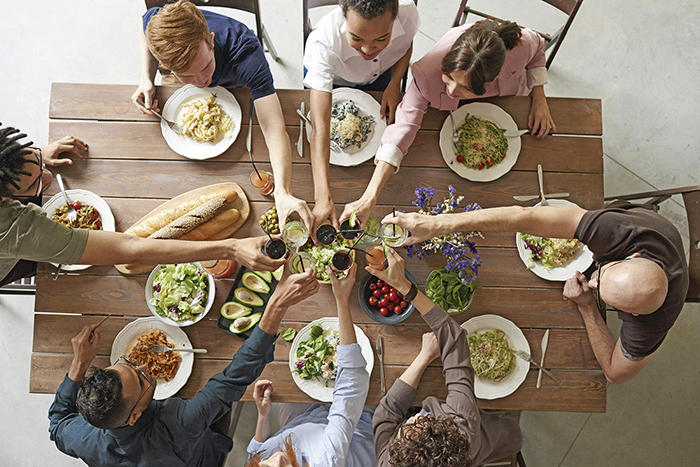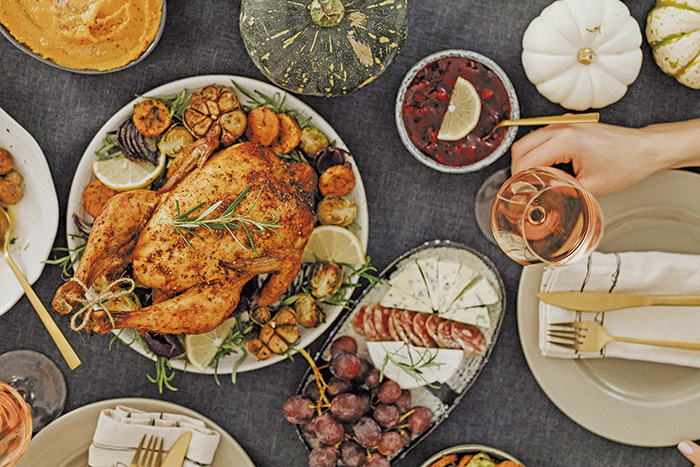By Jesus Hernandez
There are many holidays, but Thanksgiving carries the value of appreciating the good things in life, how much we have, little, or enough.
This unique holiday dates to 1620, when English immigrants landed on the coast of what we now call Massachusetts and after a harsh winter they learned from natives how to farm and hunt for food.
Historians assure that the newcomers managed to harvest corn and other grains that yielded enough to store. Therefore, those immigrants who fled their land, as it continues to happen today, thanked the natives for their teaching and welcome and invited them to a great dinner to share the collected products.
According to historical data, this was the origin of the harvest festival, which later was renamed to give thanks for everything, including life.
However, some historians claim that a part of history is riddled with myths. That’s what David Silverman suggests in his book This Land Is Their Land: The Wampanoag Indians, Plymouth Colony, and the Troubled History of Thanksgiving, where he describes, according to him, certain historical inaccuracies.
Silverman points out that life of the Wampanoag Indians was affected in a negative way after the arrival of the English migrants.
Anyway, the festivity gained popularity, and Thanksgiving was celebrated on different days from one state to another, until the majority adopted the last Thursday of November.
In fact, in 1863, then-President Abraham Lincoln proclaimed Thanksgiving Day to be celebrated on the last Thursday of November.
Years later, in 1941, the United States Congress declared the national holiday.
The place
In the northeast of the country, facing the furious North Atlantic Ocean, there are many fishing villages and large cities such as Boston.
Semi-hidden on the map, just 40 miles from the century-old city, lies the site where the English settlement took place when pilgrims from Mayflower ship arrived.
This town, which we call Plymouth today, has the credit of being the place for those looking for new lands where they could freely profess their religious faith. A location that today shows elegant mansions from yesteryear and picturesque streets.
Mayflower II
In Plymouth there is a theme park that celebrates the historic settlement. Called Plimoth Plantation, written with an “i” and missing the “u”, as the pilgrims originally called it 404 years ago, exhibits a peculiar reproduction of the original town, with wooden houses and public buildings, that resembles the places where the original inhabitants used to pray, listen to their leaders or attend to community affairs.
Plimoth Plantation is a tourist attraction that is staffed by people and tour guides who dress in old-fashioned clothing to take visitors back to the past era.
However, the main attraction is the replica of the Mayflower ship. A reproduction was made in 1956 by a group of researchers and experts that was named Mayflower II.
Since then, the unique reproduction, about 100 feet long, rests tied to the small pier, where a mausoleum and a stone remember the year 1620.
November is the time when most tourists come to Plymouth. In fact, most restaurants keep track of reservations that sell out easily. With history one side and cooler temperatures on the other, they serve the typical dinner of stuffed turkey, sweet potato, cranberry jelly, and apple pie.
Controversies
There is no shortage of those who question history: whether it was in Plymouth or another place that we know today as Berkeley Hundred, in Virginia.
Others claim that the first Thanksgiving was celebrated by Spanish explorers in Texas in 1598, in a town called today, San Elizario.
The most powerful assumption comes from the University of Florida. They claim that that first thanksgiving dinner was celebrated, also by Spaniards, in a place that we know today as San Agustín, on September 8, 1565. That is 55 years before the English pilgrims’ dinner.
Holiday
One date or another, we can assure that Thanksgiving is one of the most celebrated holidays in the country today.
Besides thanking and wishing the best, it is a day family and friends come together despite the long distances.
Most people follow the traditional menu. Others, like the Cubans in Miami, adjust the dishes to their culinary tradition: turkey marinated with bacon, rice and black beans, fried plantains or tostones.
In fact, the day that precedes the fourth Thursday in November is the busiest at airports and highways in the country. It is also the busiest day for charitable organizations that, after collecting food, give away turkeys or prepare dinners for thousands of needy people.
The best example of this in Miami is Camillus House, the homeless assistance center, which for more than 55 years has offered Thanksgiving meals to more than 500 people on this day.

Thanksgiving, gran día para compartir y agradecer
Por Jesús Hernández
Fiestas y días festivos hay muchos, pero Thanksgiving, o Día de Acción de Gracias, tiene la connotación histórica de reconocer y agradecer lo mucho, poco o suficiente que tenemos para vivir.
Esta conmovedora festividad se remonta a 1620, cuando un grupo de inmigrantes ingleses desembarcaron en la costa de lo que hoy llamamos Massachusetts y tras un duro invierno aprendieron de manos de nativos a cultivar y cazar para comer.
Historiadores aseguran que los recién llegados lograron cosechar maíz y otros granos que rindieron lo suficiente para almacenar y por ello, aquellos inmigrantes que, tal como continúa sucediendo hoy, huían de su tierra agradecieron a los nativos la enseñanza y acogida y los invitaron a una gran cena para compartir los productos recolectados.
Según los datos históricos, ese fue el origen de la fiesta de la cosecha, que más tarde, con el curso del tiempo, fue llamada para agradecer todo, inclusive la vida.
No obstante, hay historiadores que aseguran que una parte de esa historia está plagada de mitos. Al menos eso es lo que plantea David Silverman en su libro This Land Is Their Land: The Wampanoag Indians, Plymouth Colony, and the Troubled History of Thanksgiving, en el que describe ciertas imprecisiones históricas.
Silverman señala que la vida de los indios Wampanoag cambió negativamente tras la llegada de los migrantes ingleses.
Sea una cosa o la otra, la fecha ganó popularidad y Thanksgiving tuvo incluso diferentes días de un estado a otro, hasta que la mayoría adoptó el último jueves de noviembre.
De hecho, en 1863, el entonces presidente Abraham Lincoln proclamó la celebración del Thanksgiving Day el último jueves de noviembre.
Casi un siglo después, en 1941, el Congreso de Estados Unidos declaró la fecha día festivo nacional.
El lugar
En esa zona del noreste del país, frente al furioso océano Atlántico del norte, abundan los pueblos de pescadores y grandes enclaves urbanos como la ciudad de Boston.
Semi oculto en los mapas de la región, a sólo 40 millas de la urbe centenaria, yace el enclave de aquel asentamiento inglés adonde los peregrinos del barco Mayflower llegaron.
Esta localidad, que tiene por nombre Plymouth, cuenta en su haber con la fundación de quienes buscaban nuevas tierras donde profesar libremente su fe religiosa. Un lugar que hoy luce elegante casonas de antaño y calles pintorescas.
Mayflower II
En Plymouth hay un parque temático que recuerda el histórico asentamiento. Llamado Plimoth Plantation, escrito con “i” y faltando la “u”, como originalmente le llamaron los peregrinos hace 404 años, cuenta con una peculiar reproducción del poblado de antaño con calles y caminos, pequeñas viviendas que rememoran la época de entonces, así como edificaciones públicas que recuerdan donde se reunían para orar, escuchar a sus líderes o atender asuntos comunitarios.
Plimoth Plantation es una atracción turística que está ataviada por una plantilla de empleados y guías turísticos que se visten a la vieja usanza y remontan al visitante a la época representada.
No obstante, es la réplica del barco Mayflower el principal punto de atracción. Una reproducción realizada en 1956 por un grupo de investigadores y expertos en diseños naval que fue bautizada Mayflower II.
Desde entonces, la singular reproducción, de unos 100 pies de largo, descansa atada al pequeño muelle que distingue el lugar, donde también se aprecia un mausoleo y una piedra que recuerda el año 1620.
Noviembre es el mes cuando más turistas acuden a Plymouth. De hecho, la mayoría de los restaurantes atienden una lista de reservas que se agota fácilmente. Entre aires de historia y temperaturas más frescas, son muchos los que allí reproducen la cena típica de pavo relleno, batata dulce, jalea de arándano y pastel de manzana.
Polémicas
No faltan los que cuestionan el lugar dónde se celebró aquella cena: si fue en Plymouth o en otro lugar que hoy conocemos como Berkeley Hundred, en Virginia.
También hay quienes reclaman que el primer Día de Acción de Gracias fue celebrado por los exploradores españoles en Texas, en una localidad que llaman hoy San Elizario, en 1598.
Pero una de las ideas más fuertes proviene de académicos de University of Florida, quienes aseguran que esa primera gran cena de agradecimiento se realizó, también por españoles, en un lugar que hoy conocemos por San Agustín, el 8 de septiembre de 1565, o sea 55 años antes de la cena de los ingleses.
Festividad
Sea una fecha o la otra, lo que sí podemos asegurar es que hoy Thanksgiving es una de las festividades más veneradas en el país.
Además de agradecer y desear lo mejor, es un día que facilita el encuentro de familiares y amigos, que a pesar de las largas distancias buscan la forma de visitarse.
De esta manera, muchos siguen el menú tradicional. Otros, como los cubanos en Miami, adaptan los platos a su tradición culinaria: pavo reforzado con beicon, arroz y frijoles negros, plátanos maduros fritos o tostones.
De hecho, el día que preside al cuarto jueves de noviembre es el más transitado en aeropuertos y carreteras del país. También es el más ajetreado para organizaciones caritativas que, tras recabar alimentos, reparten pavos o preparan cenas para miles de necesitados.
El mejor ejemplo en Miami es Camillus House, el centro de asistencia a desamparados, que por más de 55 años ha ofrecido una cena conmemorativa a más de 500 personas el Día de Acción de Gracias.














